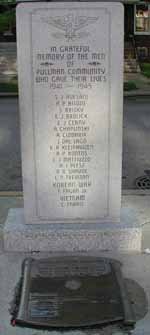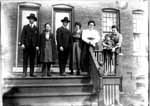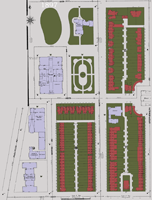Before the First World War
The War Memorial west of the current school on Forrestville Avenue lists Pullman dead from World War II, the Korean War, and the Vietnam War. Of course, Pullman had 60 years of history before the start of the Second World War. Pullman company records and newspaper clippings offer more information about other Pullmanites who served.
On March 9, 1916, Pancho Villa made a cross-border attack against Columbus, New Mexico, in response to the U.S. government's official recognition of the Carranza regime and for the loss of lives in battle due to defective bullets purchased from the United States. In response, President Woodrow Wilson sent 6,000 troops under General John J. Pershing to Mexico to pursue Villa. This became known as the Punitive or Pancho Villa Expedition. Four Pullman company employees,
C. L Stellwag, W.J Simpson, H. Peterson, and
S. Cowles, serving in the Illinois National Guard, were part of the expeditionary force. All four were given an official leave of absence from their jobs. Judging from Stellwag's description, this expedition was a nightmare of poor food, long desolate desert marches, hostile Mexican civilians, and heavy, uncomfortable packs. 10% of the force-- 600 men-- succumbed to heat prostration and had to be hospitalized.
Of course, with a large immigrant European population at the time, Pullman's residents inevitably fought in some of Europe's many wars.
Thaddeus Conway and
John Ambrose, Pullman residents and factory employees, were born in the 1840s in Ireland, where they grew up together and became friends. As young men in their early 20s, they enlisted with Garibaldi's Red Shirts to fight in the Second Italian War of Independence in the campaign of 1860. They were captured by the Austrians and spent many months as POWs. After their release, they struggled back to Ireland. Upon their return to Ireland, they went their separate ways. Both eventually made it to the U.S. Ambrose volunteered, at the age of 57, to fight in the Spanish-American war (1898). He was accepted, surprisingly, as a sergeant, and fought throughout the whole war. Both offered their services to President Wilson when the general call-up was announced for the First World War in 1917. In their late 70s, they were respectfully turned down.
The First World War
Many in Pullman did, of course, serve in the First World War. Most of the troops in Pullman served in the 35th Engineers, a unit that is still in service today. During World War I, they were active in the St. Mihiel Salient supporting the U.S.'s drive into Germany in 1918. However, before the U.S. declared war in 1917, U.S. citizens served with foreign units on one side or the other.
John H. Cartwright, for instance, served with distinction with the Canadian Army. He was killed on September 27, 1918. He was an employee of the Pullman factory and a prominent member of the factory's football team.
E. P. Spurlock, factory employee, was awarded one of the British Army's highest awards, the Military Medal, for conspicuous bravery in the service of the Wessex Engineers in 1918.
Of a sadder note was contained in an article entitled "One of Life's Derelicts." A former employee, not named in the article, down on his luck, too old to work, and dependent on charity, lived alone in destitution in Pullman. He had no one because his wife and teenage son had gone to Belgium just before the outbreak of World War I. He had not heard from them for four years, and he feared that his wife was dead and his son dead or impressed into the German Army and then killed in action.
World War I saw the advent of many terrible weapons and tactics to deal with those weapons. Pullman employees suffered hideous injuries and traumatic experiences.
Christian Anderson lost both arms and suffered head and foot wounds in the battle for Argonne Forest.
Arthur Last lost a leg and part of his jaw at the battle of Chateau Thierry.
John Kloet lost a leg in Flanders.
Hugh Davidson suffered from gas poisoning.
Edward Prybylski wrote movingly of suffering from a mustard gas shelling attack and his recovery in a field hospital.
W. H. Zimmerman wrote of learning to live with blindness after the truck we was riding in swerved to avoid a shell hole and skidded out of control.
Alex Gronquist floated in the water for hours after his ship, the
Tuscania, was torpedoed off the coast of Ireland by a German submarine.
Walter Henning floated for 22 hours before being rescued after his ship, the
Aurora, was torpedoed by a German submarine.
Our Pullman deaths in World War I resulted mainly from accidents and illnesses.
A. E. Maxie of the Manufacturing Accounting Department died on June 6, 1918 at Camp Deven in Massachusetts of an attack of spinal meningitis.
Edward D. Haigh of the Sales Department died of diphtheria in France on April 18, 1918.
Cyrill M. Angell lost control of his aircraft somewhere over Belgium and crashed.
Alexander Kaye Ogilivie of the General Superintendent's Office was involved in a mid-air collision over France while on patrol on November 29, 1918.
Of course, the saddest deaths in war are those of one's children drafted to fight.
Frederick W. Hough, son of General Auditor William Hough, died in a routine training accident while learning to fly seaplanes on March 13, 1918.
Harry Anderson, son of employee Fred Anderson, was killed as a result of enemy action in the terrible battle of Beleau Woods. Anderson was a sergeant in the USMC.
Coming home, the troops faced an even greater enemy. 1918 saw the outbreak of the "
Spanish Flu," the pandemic of influenza that swept the world between 1918 and 1919.
World War II, Korea, and Vietnam
WORLD WAR II DEAD
- Silvino J. Alvesani, born in Italy, age enlisted at 22, Private First Class in the U.S. Army, killed in action. Serial number 36378474.
- Angelo Bisone, Sergeant in the U.S. Army. Died as a result of non-battle injuries. Serial number 36979179
- Emil J. Brolick, born in Pullman, age enlisted at 21, 2nd Lieutenant in the Army Air Force, killed in action on December 27, 1944. Serial number 16135341. He is buried in the Lorraine American Cemetery and Memorial in Lorraine, France.
- Edward J. Cerny, born in Pullman, age enlisted at 24, Private First Class in the U.S. Army, died of wounds suffered in battle. Serial number 36338060.
- Alexander Chaplinsky, Fireman 1st Class, U.S. Naval Reserve. He lived at 11436 Champlain Ave. and was married to Mrs. Stella Veronica Chaplinski.
- Andrew Cizmarik, born in Pullman, age enlisted at 22, Technical Sergeant in the U.S. Army, killed in action on March 12, 1945. Serial number 36000056. He is buried in the Lorraine American Cemetery and Memorial in Lorraine, France.
- Joseph Dal Lago, born in Chicago, age enlisted at 22, Corporal, U.S. Army, killed in action. Serial number 36008941.
- Kenneth Ray Kleinhuizen, Pharmacists' Mate 3rd Class, U.S. Naval Reserve. He lived by 11345 Forrestville Ave. and was survived by his parents Mr. and Mrs. Clarence Albert Kleinhuizen. He died on April 12, 1945 and is buried in the Honolulu Memorial Cemetery.
- Anthony P. Kontos, Sergeant in the U.S. Army, died as a result of non-battle injuries on September 29, 1945. Serial number 36628219. He is buried in the American Cemetery and Memorial in Manila, the Philippines.
- Louis J. Mattiuzzo, Private First Class in the U.S. Army, killed in action. Serial number 36691446.
- Alexander J. Plesz, S2 in the U.S. Army, killed in action January 2, 1944. Serial number 6119598. He is buried in the North African Cemetery and Memorial in Tunisia.
- Ralph R. Shayne, Private in the U.S. Army, killed in action. Serial number 36749933.
- Leno P. Trevisan, Private First Class in the U.S. Army, died of wound sustained in combat. Serial number 36949252.
KOREAN WAR DEAD
Frederick R. Fagan, born in Pullman(?), Private First Class, U.S. Army Reserve.* *Private First Class Fagan was a member of the 32nd Infantry Regiment, 7th Infantry Division. He was killed in North Korea on February 14, 1953.Service Number: RA16342229.
VIETNAM WAR DEAD
Chris Frank Fabris, born, of course, in Pullman. Corporal, U.S. Marine Corps. Although his MOS was "6422 -- Aircraft Cryptographic Systems Technician," Chris operated as a door gunner in a helicopter, probably a Sikorsky H34. Born on August 3, 1943, he died on July 25, 1966 in the infamous Military Region 1 -- Quang Tri Province. Quang Tri was the northernmost province in South Vietnam and was where some of the bloodiest battles of the war were fought. Service Number: 1958298





